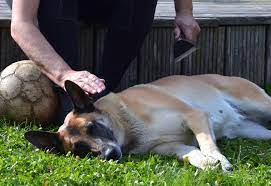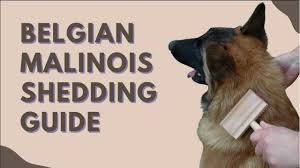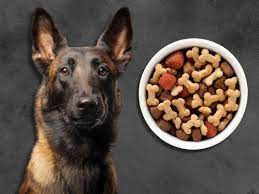Belgian Malinois is an intelligent, active, and loyal dog breed. They are often used as police, military work, and search and rescue dogs. However, before bringing Belgian Malinois into your home, it’s essential to consider their shedding habits. According to recent statistics, 60% of people surrender their pets because of behavior or health issues.
One common concern among potential pet owners is how much shedding a particular breed may have. Belgian Malinois shed moderately year-round but experience heavy seasonal shedding twice a year during spring and fall. While they don’t require excessive grooming to manage their coats, it’s essential to understand the amount of time and effort needed to clean up after them.
In this article, we’ll discuss the shedding habits of Belgian Malinois in more detail and provide tips for managing shedding effectively without compromising the bond between you and your furry friend.
Key Takeaways
- Belgian Malinois is an intelligent, active, and loyal breed of dog often used for police work, military operations, and search and rescue.
- They have moderate year-round shedding, with heavy seasonal shedding twice a year, and regular grooming can minimize shedding and prevent matting.
- Excessive shedding could indicate underlying health issues or poor nutrition, so feeding them a balanced diet with Omega 3 fatty acids is crucial.
- Shedding can lead to allergies, skin irritation, and parasite infestation, so prevention methods include regular grooming, frequent bathing, and vacuuming.
Shedding Habits of Belgian Malinois

Belgian Malinois shed, but don’t worry; it’s nothing a good vacuum and some snuggles can’t fix! Shedding frequency can vary depending on the dog, but they will generally shed heavily twice a year during seasonal changes.
During this time, they will lose their undercoat, which helps regulate their body temperature in warmer weather. Regular grooming can help minimize shedding and keep your Belgian Malinois looking sharp.
Brushing their coat at least once a week can help remove loose hair and prevent matting. It’s important to note that while shedding is a natural process for dogs, excessive shedding could be a sign of an underlying health issue or poor nutrition.
If you notice unusual amounts of shedding or bald patches on your dog, it’s best to consult with your veterinarian.
How to Manage Shedding in Belgian Malinois?

Managing shedding in Belgian Malinois can be challenging, but effective ways to keep it under control exist.
Grooming and brushing techniques are crucial in reducing the hair that falls off your dog.
A nutritious diet and environmental factors, such as temperature and humidity, also contribute to managing shedding.
Grooming & Brushing Techniques
When grooming and brushing your Belgian Malinois, it’s essential to remember that they’re highly active dogs who love spending time outdoors. Therefore, their fur can accumulate dirt and debris quickly.
Brushing them frequently can help maintain the cleanliness of their coat. Experts recommend brushing your Malinois at least once a week to remove loose hair and prevent matting.
Aside from regular brushing, taking your Belgian Malinois to a professional groomer every few months is essential. Groomers use special tools and techniques to ensure your dog’s coat stays healthy and shiny. They can also trim their nails, clean their ears, and bathe them.
Professional grooming enhances your dog’s appearance and promotes good hygiene for their overall well-being.
Dietary Considerations

Feeding your Malinois a balanced diet is crucial to keeping them healthy and happy, so choosing high-quality dog food is essential.
When considering the dietary needs of Belgian Malinois, it’s important to remember that they are an active breed with high energy requirements. Their diet should be rich in protein sources such as chicken, beef, and fish to support muscle growth and development.
In addition to protein sources, Omega 3 fatty acids are essential for maintaining good health in your Malinois. These healthy fats can be found in fish oil supplements or added directly into their food.
Omega 3s help promote healthy skin and coat by reducing inflammation and preventing dryness. They also aid in cognitive function by supporting brain development and improving memory retention.
Your Belgian Malinois will thrive physically and mentally with proper nutrition and care.
Environmental Factors
You can’t underestimate the impact of environmental factors on your Belgian Malinois’ physical and mental health, so it’s crucial to be aware of their surroundings and make necessary adjustments.
Here are three things you should consider when it comes to your Malinois environment:
- Indoor vs. Outdoor: While Belgian Malinois dogs love spending time outdoors, they also need a comfortable indoor space to rest and relax. Indoor time is significant during extreme weather conditions like heavy rain or snow, which can cause discomfort or illness in your pet.
- Temperature Control: It’s essential to keep the temperature inside your home comfortable for your Belgian Malinois. These dogs thrive in moderate temperatures (around 60-70 degrees Fahrenheit) and may experience heat exhaustion or hypothermia if exposed to extreme temperatures for prolonged periods.
These environmental factors will help ensure your Belgian Malinois stays physically and mentally healthy. As a responsible owner, it’s up to you to provide a safe and comfortable living space for your furry friend!
Is There a Health Risk from Shedding in Belgian Malinois?
Belgian Malinois shedding can lead to various health concerns that owners should be aware of. Allergies and skin irritation are common issues related to shedding, as the loose fur can cause itchiness and discomfort.
Parasite infestation is risky, as fleas and ticks may hide in the dog’s coat. Additionally, respiratory problems can arise if too much hair is inhaled or the home’s air quality is poor due to excessive shedding.
Allergies and Skin Irritation
Despite its short and dense coat, the Belgian Malinois can still cause allergies and skin irritation in some individuals. This can be especially problematic for people prone to allergies or sensitive skin.
Prevention methods such as regular grooming, frequent bathing, and vacuuming the home can help reduce the dander and hair the dog sheds. However, if someone does experience allergies or skin irritation from a Belgian Malinois, treatment options are available.
One option is to take over-the-counter antihistamines to alleviate allergy symptoms. If someone experiences severe allergic reactions such as difficulty breathing or facial or throat swelling, they should seek medical attention immediately.
Additionally, topical creams or ointments may soothe irritated skin caused by contact with the dog’s fur. It’s important to note that while these treatments may relieve symptoms, they do not address the underlying cause of allergies or sensitivity to dog fur.
Therefore, it’s essential to consult a doctor before adopting a Belgian Malinois if one has a history of allergies or skin issues.
| Emotion | Description | Example |
|---|---|---|
| Fear | The feeling of being scared or anxious about something | “The fear of having an allergic reaction prevented her from considering getting a Belgian Malinois.” |
| Relief | A feeling of relaxation after stress or anxiety has been alleviated | “She felt relieved knowing that there were treatment options available if she were to experience any allergies from her pet.” |
| Frustration | The sensation of being upset or annoyed due to obstacles in achieving something | “He felt frustrated because his allergy medication wasn’t providing enough relief from his symptoms.” |
| Empathy | Understanding and sharing another person’s feelings | “As someone who also suffered from allergies, she empathized with those who had similar struggles when it came to owning pets.” |
Parasite Infestation
One of the challenges of owning a Belgian Malinois is dealing with pesky parasites that can infest their coat. These parasites, such as fleas and ticks, cause your dog discomfort and transmit diseases.
It’s essential to take preventive measures against these pests by regularly inspecting your dog’s fur and using products like flea collars or topical treatments. Various treatment options are available if your Belgian Malinois becomes infested with parasites.
Your veterinarian may recommend medication or topical treatments to rid your dog of the infestation. It’s essential to follow their instructions carefully and continue any necessary treatment until all parasites have been eliminated from your dog’s coat.
By taking preventative measures and seeking the proper treatment when necessary, you can keep your Belgian Malinois healthy and free from pesky parasites.
Respiratory Issues
You may experience worry and fear if your furry companion shows signs of respiratory issues. Like all dogs, Belgian Malinois are prone to respiratory problems that can cause discomfort and distress.
Causes of respiratory issues in dogs include allergies, infections, inflammation, and cancer. To treat the respiratory problems in your Belgian Malinois, it’s essential first to determine the underlying cause.
Some standard treatment options include antibiotics or anti-inflammatory drugs, nebulizer therapy for severe cases, or even surgery in extreme situations. Working closely with your veterinarian is crucial to ensure proper diagnosis and treatment for your beloved pet’s respiratory health.
By being proactive and seeking medical attention when necessary, you can help keep your furry friend healthy and happy for years.
Shedding vs. Hypoallergenic Breeds
If you’re looking for a hypoallergenic breed, the Belgian Malinois may not be your first choice as they do shed. However, shedding is not always an indicator of allergic reactions in people. Some breeds that don’t shed much can still trigger pet allergies due to their dander or saliva.
Here are a few things to keep in mind when considering sheds vs. hypoallergenic breeds:
- Shedding does not necessarily mean a pet will cause allergies.
- Non-shedding breeds may still produce allergens that can trigger symptoms.
- Regular grooming and cleaning can help reduce the amount of allergens in a home with pets.
- It’s essential to consult with an allergist before bringing any pet into your home if you have known allergy concerns.
Final Thoughts
To wrap things up, it’s essential to remember that shedding is not the only factor when considering pet allergies. Regular grooming can also help reduce allergens in your home. Additionally, there are ways to embrace shedding and use it as an opportunity to bond with your Belgian Malinois.
One way to embrace shedding is through frequent brushing sessions. Not only does this help remove loose fur, but it also allows for quality time between you and your dog. Another way is to incorporate a healthy diet and regular exercise routine, promoting healthy skin and coat growth. Shedding may seem daunting to own a Belgian Malinois, but with the right approach, it can become just another way to strengthen the bond between pet and owner.
Frequently Asked Questions
How much does a Belgian Malinois shed compared to other dog breeds?
Belgian Malinois shed moderately compared to some other breeds. Regular grooming techniques like brushing and bathing can help reduce shedding; shedding prevention supplements may also be helpful.
Is there a specific time of year when Belgian Malinois shed more?
During shedding season, Belgian Malinois shed their thick undercoats heavily. Shedding can be managed by regularly brushing their coats and providing a balanced diet. This helps keep the shedding under control for those who desire to serve others with a clean home.
Can grooming or diet affect the amount a Belgian Malinois sheds?
Grooming techniques and dietary supplements can affect the amount a Belgian Malinois sheds. Regular brushing with proper tools can decrease shedding, while adding omega-3 fatty acids to their diet may improve coat health and reduce shedding.
Do Belgian Malinois have any unique shedding patterns or behaviors?
Belgian Malinois have a unique shedding pattern, which requires proper grooming and regular brushing to prevent excessive hair loss. Managing their environment and shedding prevention techniques can help reduce symptoms for those with allergies.
How does Belgian Malinois compare in shedding to other Malinois breeds, such as Dutch Malinois or French Malinois?
There are some differences when comparing Belgian Malinois shedding to Dutch or French varieties. However, all Malinois breeds shed moderately year-round and require regular grooming to manage their double coats. Frequent brushing and occasional baths can help keep shedding under control.
Conclusion
Now that we’ve explored the shedding tendencies of Belgian Malinois, we hope you have a better understanding of what to expect. These incredible dogs are known for their intelligence, loyalty, and versatility. While they do shed, regular grooming and maintenance can help manage it effectively.
At Bone Voyage Dog Rescue, we have a variety of unique dogs, including Belgian Malinois, waiting for their forever homes. If you’ve fallen in love with the breed, we encourage you to consider adoption. By adopting from Bone Voyage Dog Rescue, not only will you gain a loving and devoted companion, but you’ll also be giving a deserving dog a second chance at life.
Visit our website today to meet the dogs and learn more about the adoption process. Let’s embark on this incredible journey together and positively impact a dog’s life. Join us at Bone Voyage Dog Rescue, where love and compassion find their forever homes.
